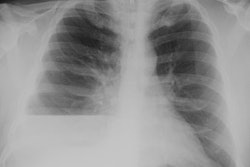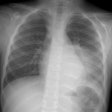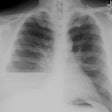Thoracic Splenosis:
Clinical:
Thoracic splenosis is defined as autotransplantation of splenic tissue into an abnormal location following splenic rupture [1]. The most common locations for splenic implants to be found are the mesentery, peritoneum, and omentum [5]. Although rarely reported, the thoracic splenosis may be found in up to 18% of patients following splenic rupture and the affected patients generally have an associated diaphragmatic tear [1,3,5]. Nearly all patients have a history of trauma- most commonly a gun shot wound or penetrating injury. Most patients are asymptomatic, however, presentation with pleursy [5] and hemoptysis have been reported [2]. All reported cases have involved the left hemithorax [1]. The splenic implants derive their blood supply from the surrounding tissue and can range in size from a few millimeters to 6 cm in diameter [3]. Lesions can be found on the visceral or parietal pleura or on the interlobar fissures. Lesions have not been described in the lung parenchyma. Prospective diagnosis is important because if the thoracic implants are the patients only remaining functioning splenic tissue- surgical removal may expose the patient to increased risk of infection with encapsulated organisms [1,4].X-ray:
Radiographic findings are often non-specific as splenosis appears as a pleural based soft tissue mass or masses. On CT, multiple pleural based nodules are identified in about 75% of cases and there is a solitary pleural based mass in the remaining 25% [5]. The lesions have Hounsfield density measurements similar to normal spleen [5]. Signal intensity on MR images is also comparable to normal spleen. Nuclear scintigraphy with heat-damaged RBC's can confirm the diagnosis non-invasively [5].REFERENCES:
(1) RadioGraphics 1998; White CS, Meyer CA. General case of the day. 18: 255-257
(2) Chest 1992; Cordier JF, et al. Thoracic splenosis presenting with hemoptysis. 102 (2): 626-627
(3) AJR 1993; Normand JP, et al. Thoracic splenosis after blunt trauma: Frequency and imaging findings. 161: 739-741
(4) Thorax 1994; Madjar S, et al. Thoracic splenosis. 49: 1020-1022
(5) AJR 2006; Huang AH, Shaffer K. Thoracic splenosis. 239: 293-296




